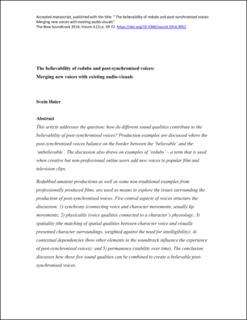The believability of redubs and post-synchronised voices: Merging new voices with existing audio-visuals
Peer reviewed, Journal article
Accepted version

Åpne
Permanent lenke
https://hdl.handle.net/11250/2685141Utgivelsesdato
2014Metadata
Vis full innførselSamlinger
Sammendrag
This article addresses the question: how do different sound qualities contribute to the believability of post-synchronised voices? Production examples are discussed where the post-synchronised voices balance on the border between the ‘believable’ and the ‘unbelievable’. The discussion also draws on examples of ‘redubs’ – a term that is used when creative but non-professional online users add new voices to popular film and television clips. Redubbed amateur productions as well as some non-traditional examples from professionally produced films, are used as means to explore the issues surrounding the production of post-synchronised voices. Five central aspects of voices structure the discussion: 1) synchrony – connecting voice and character movements, usually lip movements; 2) physicality – voice qualities connected to a character's physiology; 3) spatiality – the matching of spatial qualities between character voice and visually presented character surroundings, weighted against the need for intelligibility; 4) contextual dependencies – how other elements in the soundtrack influence the experience of post-synchronised voices; and 5) permanence – stability over time. The conclusion discusses how these five sound qualities can be combined to create a believable post-synchronised voice.